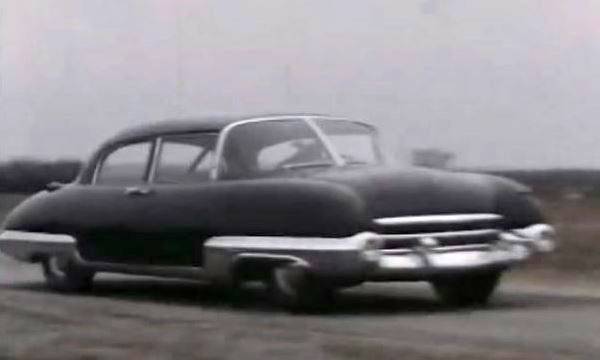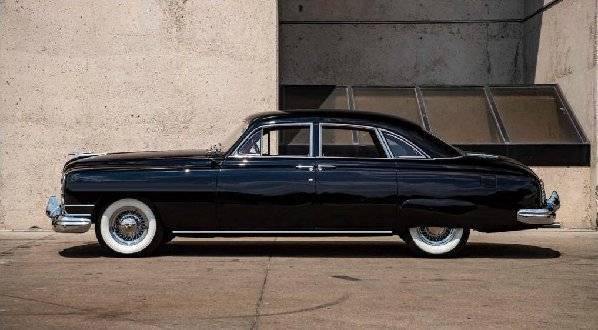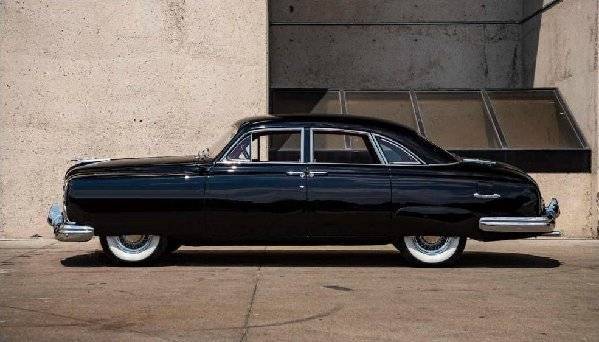|
Re: Synopsis of forces and events leading to '48-'50 styling
|
||||
|---|---|---|---|---|
|
Forum Ambassador

|
I enjoyed your piece, nicely done. Let me offer a clarification; the 22nd/23rd series long wheelbase sedan bodies were built by Briggs, not Henney. Henney was fully committed to their new line of professional vehicles. An explanation is in the chapter on the long wheelbase sedans in Bob Neal's book.
Posted on: 2020/3/17 10:26
|
|||
|
||||
|
Re: Synopsis of forces and events leading to '48-'50 styling
|
||||
|---|---|---|---|---|
|
Home away from home
|
Nice summary. The Chrysler Thunderbolt and Newport prewar show cars were also influential, it would seem to me. While styling is as you say subjective, the requirement to reuse the Clipper tooling while having a flow-through side is what drove the doors being wider than the greenhouse. The closed cars' proportions are made a bit odd by this. The convertible won a styling prize.
I don't agree on GM having handled the styling era well - their financial muscle carried them through. The post-war Cadillac design still had rear fenders, as did Chevrolet through 54. The Independents led the way out of pre-war styling.
Posted on: 2020/3/17 14:02
|
|||
|
||||
|
Re: Synopsis of forces and events leading to '48-'50 styling
|
||||
|---|---|---|---|---|
|
Home away from home

|
Wonderful synopsis Steve!!! You've captured all the major forces acting on the historic situation that Packard found itself in.
John Reinhart said that he and many other designers wanted to simply refine the Clipper with a theme he referred to as needle nose. Wonder if any sketches or pictures survived. Why didn't pinch-penny Christopher figure out how to marry Clipper's dies to Packard's pre-war stamping presses, to inexpensively bring body production back in-house in 1945? The company invested a boatload in those presses for 1938, surely the equipment hadn't become obsolete 7 short years later. Did Packard let the expensive equipment sit outside? How would it have even been moved? Its hard to imagine it doing nothing more than staying right were it had always been. Briggs should have been a seen as nothing more than a temporary arrangement.
Posted on: 2020/3/17 14:48
|
|||
|
||||
|
Re: Synopsis of forces and events leading to '48-'50 styling
|
||||
|---|---|---|---|---|
|
Home away from home
|
what was Packard's relationship with Budd at this time? The 41 bodies before the Clipper used door stampings from Budd. Could they have been an alternate to Briggs?
Posted on: 2020/3/17 15:08
|
|||
|
||||
|
Re: Synopsis of forces and events leading to '48-'50 styling
|
||||
|---|---|---|---|---|
|
Home away from home

|
Hi
Thanks for all your considered responses and perspectives. Each in turn: Dave "Let me offer a clarification; the 22nd/23rd series long wheelbase sedan bodies were built by Briggs, not Henney. " That is a good point, I briefly considered including it but decided it was a bit of esoteric detail not directly germane to the subject of the series styling. Bkazmer "The Chrysler Thunderbolt and Newport prewar show cars were also influential,..." "I don't agree on GM having handled the styling era well - their financial muscle carried them through. The post-war Cadillac design still had rear fenders, as did Chevrolet through 54. The Independents led the way out of pre-war styling. " Indeed, both the Chrysler Thunderbolt and Newport by LeBaron, especially the former, were highly influential on the designers of the period when developing their visions of postwar cars. 'Evolutionary, never revolutionary' might well have been Harley Earl's personal mantra when selecting which designs would be promoted for production. Allowing the independent automakers to pioneer, or maybe better described as being the guinea pigs, to try out advanced radical styling in production gave GM immediate feedback whether a new design direction would find general acceptance or be rejected. Misterl summarily rejected the pudgy, fully-envelope styling developed for the postwar Cadillac as late as the running metal prototypes. Variously named the "Interceptor" or "C.O." for Commissioned Officer, in one of this famous turnarounds, Earl one day told his staff "To hell with that big blown-up thing (referring the C.O.)". At which point they developed an evolutionary version first seen on the '42 Buick sedanette and convertible. The hood/cowl surface continues along the beltline, whereas the front fender line proceeds reward at full height until it dives behind the rear fender forms. This creates a flatter rounded section and a step in the visual height rather than one large pudgy fat roll top to bottom. The separate rear fenders rendered a crouching haunches look as in an animal about to leap. All the familiar forms were still present. This same concept is seen on the 1947 Studebaker. After the Free-Flow styling experience, Reinhart decided to include the vestigial rear fenders in the Contours as a visual break as well. "what was Packard's relationship with Budd at this time? The 41 bodies before the Clipper used door stampings from Budd. Could they have been an alternate to Briggs?" Budd supplied stamping and complete bodies to a wide variety of carmakers, component stamping for assembly in the carmaker's plants were a major part of their business. They developed the all-steel bodies Dodge and Ford used early on. During the 1930's Chrysler was a major customer with the Airflow as Budd had experience with unit-body construction from their European operations, the Citroen Traction Avant being one. This came to play leading to both the Nash 600 and step-down Hudsons. Studebaker was a major customer for their stampings to the end. The Budd Co. topic on Coachbuilt.com tells the history very well. Packard doesn't appear to have been a major customer. Apparently with the Clipper, Briggs finally had a complete grip on Packard's volume body business including the stampings. From what has been written, the cozy Packard-Briggs relationship seems to have developed as Briggs assisted closely in the Clipper's design, willingly took over its construction to free up plant space as Packard accepted more ordinance materiel work. Walter Briggs and Alvan Macauley were friends and business associates so when it came to who owned what stamping presses that had been transferred from Packard to Briggs, there was nothing in writing to determine that. Being dependent on a sole supplier was painting themselves into a corner when things went sour. Paul West (Mahoning63) "John Reinhart said that he and many other designers wanted to simply refine the Clipper with a theme he referred to as needle nose. Wonder if any sketches or pictures survived?" If those sketches have survived, they haven't been identified yet. What the refinement of the Clipper themes were may not have impressed Ed Macauley as being advanced enough to give Packard an edge. The progression of the Brown Bomber customization process seems to be the best window into the thinking as each new feature and detail found its way from the clay to a work-up in metal. Not having a parallel path of alternatives to select from essentially doomed the car to have the styling as it developed. The pitfalls of a tiny, underdeveloped styling department when such was becoming critical to remain competitive. Steve Attach file:  (18.79 KB) (18.79 KB)
Posted on: 2020/3/18 13:17
|
|||
|
.....epigram time.....
Proud 1953 Clipper Deluxe owner. Thinking about my next Packard, want a Clipper Deluxe Eight, manual shift with overdrive. |
||||
|
||||
|
Re: Synopsis of forces and events leading to '48-'50 styling
|
||||
|---|---|---|---|---|
|
Forum Ambassador
|
Quote:
The company invested a boatload in those presses for 1938, surely the equipment hadn't become obsolete 7 short years later. Don't know about obsolete but I think it might have been Ward's book that mentioned when Packard revamped for war production they did move a lot of tooling and production machinery outside and let it sit relatively unprotected during the war. Perhaps it was not obsolete but more the equipment was considered aging and was damaged enough to not warrant investing a lot more money to fix it when there was a less costly alternative that could be ready for postwar production sooner.
Posted on: 2020/3/18 14:08
|
|||
|
Howard
|
||||
|
||||
|
Re: Synopsis of forces and events leading to '48-'50 styling
|
||||
|---|---|---|---|---|
|
Home away from home

|
To quote one packard engineer: "We were tooling ourselves to death..." when referring to the multiple wheelbases, chassis, and bodies they were building before the war. So the Clipper line boils down to pure economics. Given the Packard balance sheet didn't improve one lick between 1929 and 1942 it is easy to understand dropping the old shop worn body styles in favor of the Clipper. There is little evidence in the automotive press of anybody bemoaning the postwar styling. The notion of damaged tooling gains some credence considering how much the ZIS built bodies appear a hybrid of Cadillac and Packard styling.
While the bathtub look became controversal among those suffering from the Gatsby syndrome, good art is always controversal, and in some ways the bathtubs looked better than the Clipper. The argument that Cadilllac styling sunk Packard is something I don't find compelling. The Reinhardt styling is much lighter and more modern than the bloated GM products of the same period. Although I always thought the grille was too heavy. However, Cadillac had a superior powertrain in all respects from 1949 onward. When I get behind the wheel of a period Chevrolet with stick shift I am impressed by how balanced they are. I can't say that about those Packards. But it isn't until 1963-64 when the automotive press began calling Cadillac a true world class luxury car. That can't be said today. The Cadillac sedans of today don't ride any better than a $15,000 Toyota Yaris.
Posted on: 2020/3/18 15:52
|
|||
|
||||
|
Re: Synopsis of forces and events leading to '48-'50 styling
|
||||
|---|---|---|---|---|
|
Home away from home

|
Kimes' book said the U.S. government reimbursed Packard to fix damaged equipment and that the company's real problem was the extensive time spent repairing, which delayed restart of production and cost the company lost sales.
It seems to have taken Mr. Earl almost a decade to finally get the C.O. theme right, see Strato Streak. Never saw the wisdom in spending half to two-thirds the cost of an all-new program to do a major refresh as Packard did for '48 and '55. Better to wait a year to do all-new. The '49 Cosmopolitan probably makes the best argument why. Packard was at a cross-roads. They needed scale and the dealers needed a mix of lower and higher priced vehicles that were completely different in size, appearance, performance and comfort. Too bad Packard couldn't strike a deal with FoMoCo, the '49 Ford with longer axle-dash would have made a good Eight while Cosmo would have led to a wonderful Custom. Image below has two inches added to axle-dash to get the wheelbase up to Packard's traditional 127 and to better package the long Eights, backlight is a more private one-piece affair and taillights have more bling. Long, low, clean and a one-piece windshield. Thoroughly modern for the times. More realistically, they might have struck a love-without-marriage deal with George Mason when he first approached them in 1946. A car like the Cosmo and a shorter-hooded version for Ambassador might have given the new platform its needed scale, with body-on-frame and panels stamped in Kenosha and shipped nested to EGB for body build, paint and final. Nash could have gone ahead with its '49 Airflyte unibody fastback, with Packard shipping the 282 Eight to Kenosha to replace what would have been the 121 wb Ambassador (now with open front wheels) and built alongside Pacemaker. These are just examples of the type of thinking they needed. What happened to that once great and gutsy company that sat atop the industry, fueled by big thoughts and in total command of its business and the industry?
Posted on: 2020/3/18 20:37
|
|||
|
||||
|
Re: Synopsis of forces and events leading to '48-'50 styling
|
||||
|---|---|---|---|---|
|
Home away from home

|
I suppose this is what the Ambassador would have looked like in general terms, Nash shipping its big Six to EGB, Packard building all the large BoF bodies. Pricing would have been up there with Hudson Commodore.
Posted on: 2020/3/18 21:45
|
|||
|
||||












